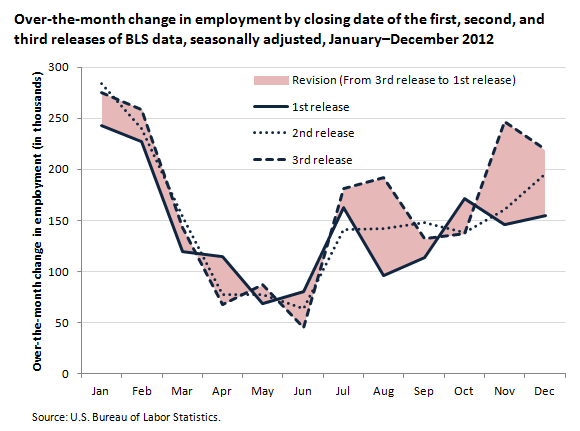An official website of the United States government
 United States Department of Labor
United States Department of Labor
At the beginning of each month, the Bureau of Labor Statistics (BLS) reports the change in payroll employment for the previous month. When the estimate is revised in subsequent months, however, data users sometimes perceive a very different picture of the job market than what was initially reported. Why is the initial estimate revised? The revised estimate includes additional information that was not available at the time of the initial release, making the revised estimate more accurate.
Differences between the initial and revised estimates generally indicate that the employment change that occurred at the businesses that had not initially reported was different than the change that occurred at the businesses that had initially reported. For example, if less employment growth occurred among those who had not reported at the time of the first estimate, the initial estimate would be revised down. If more growth occurred among the late responders, the initial estimate would be revised up.

| Month | Seasonally adjusted | |||||
|---|---|---|---|---|---|---|
| Over-the-month change | Revision in over-the-month change | |||||
| 1st release | 2nd release | 3rd release | 2nd - 1st release | 3rd - 2nd release | 3rd - 1st release | |
January 2012 | 243,000 | 284,000 | 275,000 | 41,000 | -9,000 | 32,000 |
February 2012 | 227,000 | 240,000 | 259,000 | 13,000 | 19,000 | 32,000 |
March 2012 | 120,000 | 154,000 | 143,000 | 34,000 | -11,000 | 23,000 |
April 2012 | 115,000 | 77,000 | 68,000 | -38,000 | -9,000 | -47,000 |
May 2012 | 69,000 | 77,000 | 87,000 | 8,000 | 10,000 | 18,000 |
June 2012 | 80,000 | 64,000 | 45,000 | -16,000 | -19,000 | -35,000 |
July 2012 | 163,000 | 141,000 | 181,000 | -22,000 | 40,000 | 18,000 |
August 2012 | 96,000 | 142,000 | 192,000 | 46,000 | 50,000 | 96,000 |
September 2012 | 114,000 | 148,000 | 132,000 | 34,000 | -16,000 | 18,000 |
October 2012 | 171,000 | 138,000 | 137,000 | -33,000 | -1,000 | -34,000 |
November 2012 | 146,000 | 161,000 | 247,000 | 15,000 | 86,000 | 101,000 |
December 2012 | 155,000 | 196,000 | 219,000 | 41,000 | 23,000 | 64,000 |
So why doesn’t BLS wait until it has all the reports to make the estimate and avoid revisions? Users of the data are intensely interested in the earliest possible read on labor market developments, and experience suggests that the initial estimate is generally very good. For example, in 2012, the average monthly employment change using the first estimate would have been +142,000, compared with a monthly average change of +165,000 using the third estimate. Nevertheless, it is true that in some months, revisions are large enough that they change the users’ perspectives on the current state of the economy. In November 2012, for example, the initial estimate of over-the-month change was +146,000, while the third estimate was +247,000.
These data are from the Current Employment Statistics Survey. To learn more, see “Why are there revisions to the jobs numbers?” (HTML) (PDF), by Thomas Nardone, Kenneth Robertson, and Julie Hatch Maxfield, Beyond the Numbers, July 2013.
Bureau of Labor Statistics, U.S. Department of Labor, The Economics Daily, Why are there revisions to jobs numbers? at https://www.bls.gov/opub/ted/2013/ted_20130729.htm (visited December 21, 2025).

